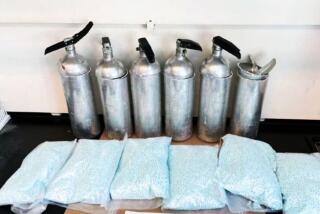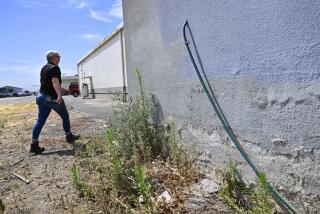Anthrax inquiry widens to 24 labs in 11 states, two foreign countries
A widening Pentagon investigation found late Friday that an Army biodefense facility in Utah has been mistakenly sending out live deadly anthrax samples to at least two dozen private and military laboratories around the world for the last seven years.
The military said the laboratories, located in 11 U.S. states as well as South Korea and Australia, are believed to have received suspect samples since 2008 via commercial shipping companies. There are currently 26 people are being treated for potential exposure.
Despite the widespread investigation, the Pentagon says the inadvertent shipments of anthrax samples to the military and commercial facilities, including to California, pose no risk to the general public and an “extremely low risk to lab workers.”
Four workers at commercial labs in Delaware, Texas and Wisconsin were given antibiotics as a safeguard, the Pentagon said. Another 22 are being treated or vaccinated at a U.S. military lab in South Korea, where emergency response teams destroyed the sample at Osan Air Base.
The Pentagon launched its own high-level review Friday, looking into military lab procedures, processes and protocols to find out how such a mistake could happen. Military leadership advised all labs that have received samples labeled “inactive anthrax” to stop working with those until further instruction.
The investigation will be headed by Deputy Defense Secretary Robert Work, who is second in command at the Pentagon.
“The department takes this matter very seriously and is acting with urgency to address this matter and … expects review findings within 30 days,” the Pentagon said in a statement.
The U.S. Centers for Disease Control and Prevention said it had sent investigators to the labs and was working with the Pentagon, as well as state and federal agencies, on its investigation.
The incident began last month when live Bacillus anthracis spores were accidentally sent from the Army’s Dugway Proving Ground, about 85 miles southwest of Salt Lake City, to labs working to develop a new diagnostic test for anthrax.
The spores were supposed to be rendered inactive via gamma radiation before they were sent to labs for study, but on May 22 a commercial lab in Maryland found that one of its samples contained live spores when it was cultured on Friday. The lab reported the discovery to the CDC.
Dugway is used to test defense systems for chemical and biological weapons agents, including lethal viruses and bacteria. After the report was made, officials at the base told the 18 labs in nine states and South Korea that their samples could contain live anthrax.
None of the labs were publicly identified, but their locations were broadly reported to be in California, Delaware, Maryland, New Jersey, New York, Tennessee, Texas, Virginia and Wisconsin.
On Friday, the Pentagon added Massachusetts, Utah and Australia to the list after scientists at Dugway began reviewing old batches of anthrax spores that were sent out over the years. One sample from a batch sent to Australia in 2008 was found to be alive, the Pentagon said.
It is still unclear how far back the mistaken shipments have taken place, and officials are trying to determine the source of the error, but Dugway is known to have had mistakes in the past.
In 2011, Dugway was put on lockdown overnight when a vial of deadly VX nerve agent went missing. The vial later was found, but had been mislabeled.
Anthrax is an acute bacterial disease that can be fatal if not treated. It is not contagious but can be inhaled, ingested or transmitted through direct contact on the skin. Someone who is infected may not show symptoms for weeks.
Last June, Michael Farrell, the head of the CDC’s Bioterror Rapid Response and Advanced Technology Laboratory, resigned after the lab failed to properly kill live anthrax samples and moved the material to an area where workers were not required to wear protective gear.
Dozens of people were exposed, but no one was discovered to be infected.
Follow @wjhenn for military and defense info.
More to Read
Start your day right
Sign up for Essential California for news, features and recommendations from the L.A. Times and beyond in your inbox six days a week.
You may occasionally receive promotional content from the Los Angeles Times.







